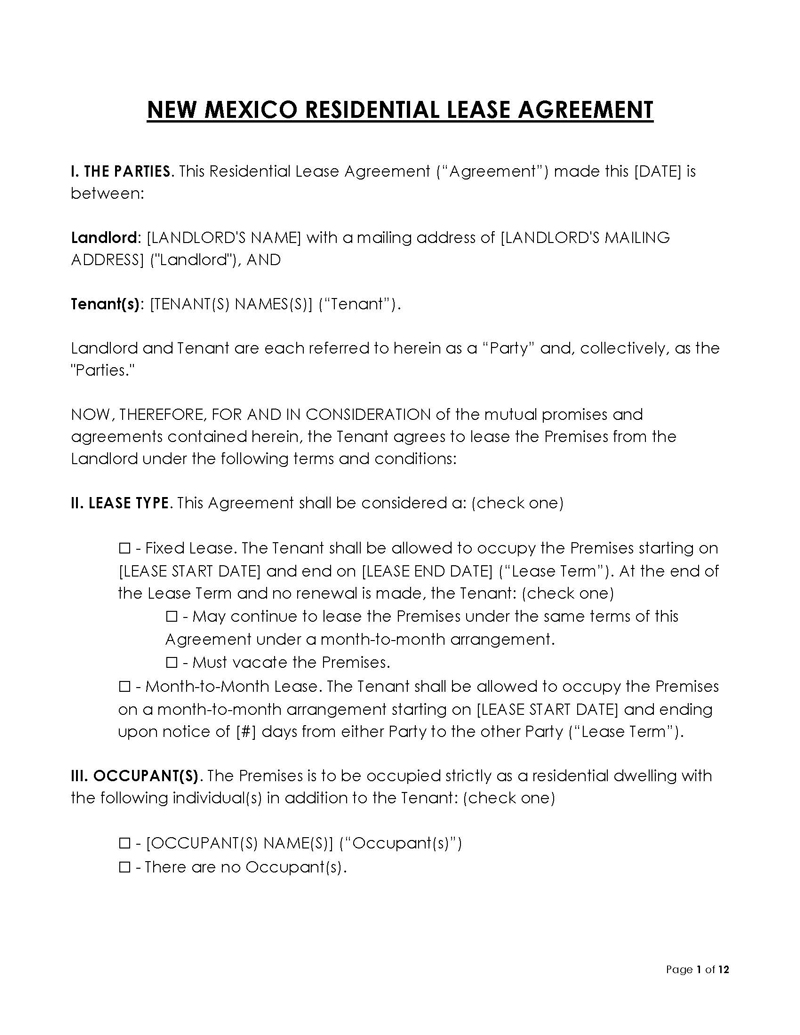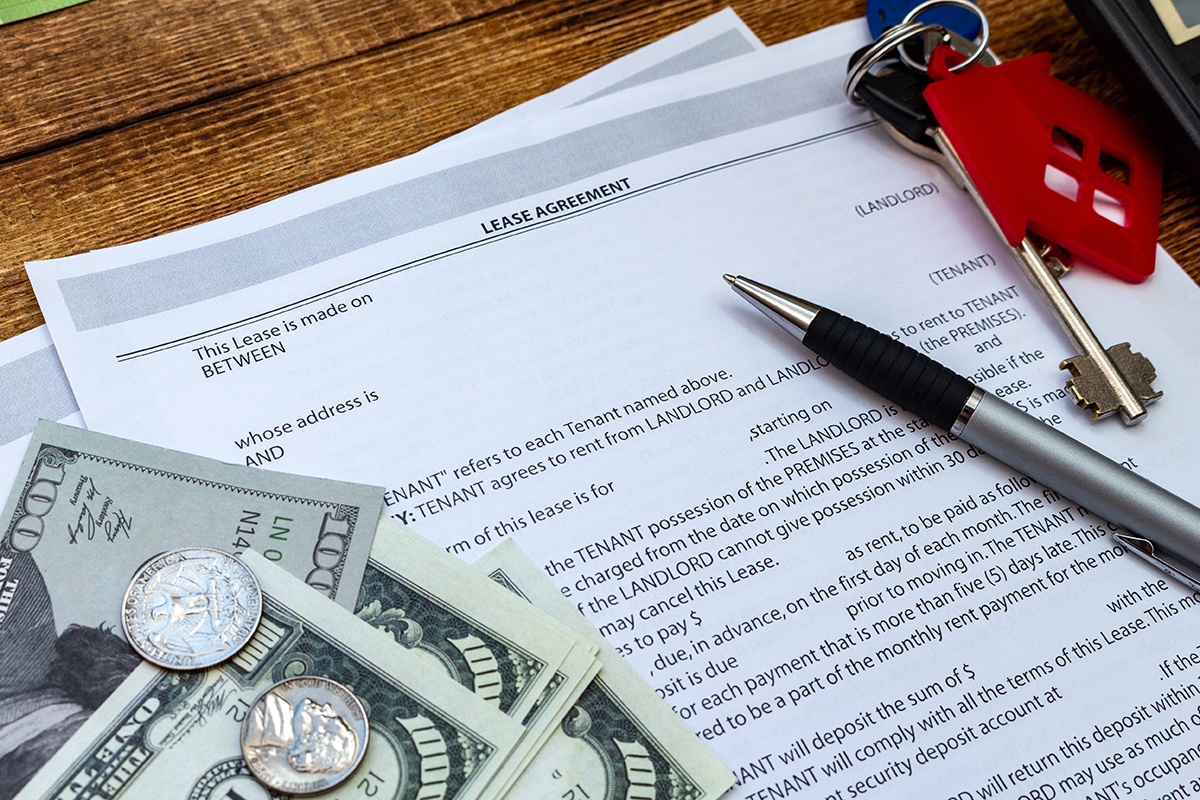Every state in the United States has its laws, statutes, and formats for lease agreements. Whether you’re a landlord leasing out your property or a tenant about to move into a new apartment, you must sign this agreement.
EXAMPLE
A New Mexico lease agreement is a legal document that signifies the contract between a landlord or property manager (lessor) and a tenant (lessee) for private or commercial properties.
You’ll be learning about the critical components of this agreement, legal requirements, and how to write it in this comprehensive article.
What is a New Mexico Lease Agreement?
It is a written document that highlights the contract between a landlord (or a property manager) and a tenant for a residential or commercial property. The document contains all the provisions of the law and the rights and obligations of both stakeholders involved in the lease of the property unit.
Generally, under the state’s rental laws, the terms to be included in the agreement include the length of the lease, the rental amount, periodic payments, costs of utilities and similar services, rent renewal and termination information, security deposit fee, property maintenance, parking details, pet policies, the penalty for late payments, and other necessary details.
According to New Mexico State Statutes, a tenant must pay a maximum of 1 month’s rent as the security deposit to their landlord before claiming ownership of the property. Similarly, as a landlord, it is recommended that you verify a potential tenant’s credit and their ability to pay the monthly rent through their rental application.
However, like every other legal contract, a lease agreement should be written, and both stakeholders must read through it to understand the terms before signing. In addition, once this agreement is signed, it’s legally binding.
Lease Agreement by Types
Generally, when creating a lease agreement, they must align with the type of property being rented.
The different types include:
Generally, when creating a lease agreement, they must align with the type of property being rented. The different lease agreement types include:
Association of realtors
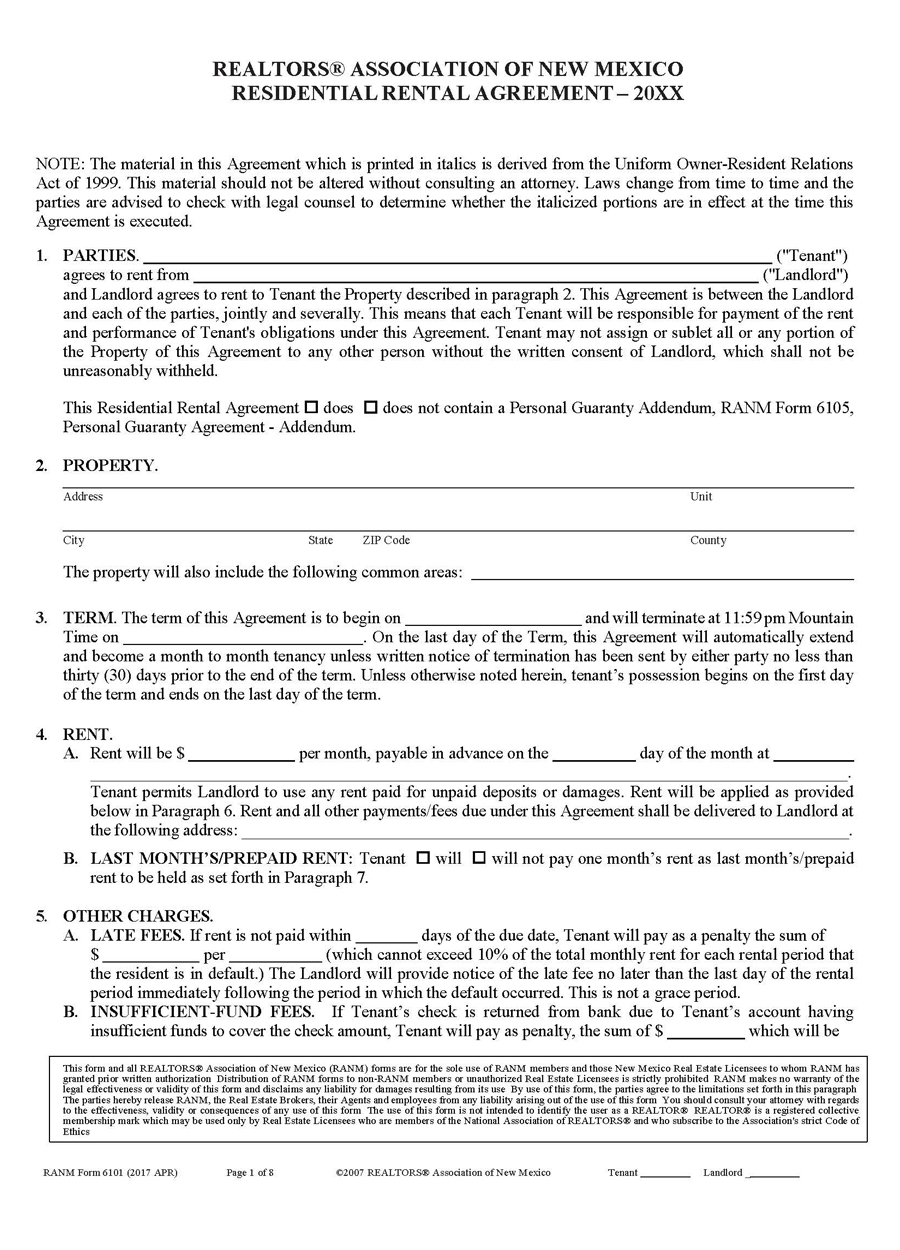
A New Mexico association of realtors lease agreement is a legal contract between a landlord and tenant for a residential property. The realtor handles the transaction for a commission, from showing the property to potential tenants to verifying the tenant’s credit and employment, negotiating the agreement terms, and handing over the necessary information to the landlord for the lease to be signed.
Commercial lease agreement

When leasing an office space, industrial property, or a property for business use, a New Mexico commercial lease agreement must be signed by both the lessor and lessee. The document must also highlight all of the agreement terms, including rent amount, late fees, security deposit, lease term, option to renew the lease, etc. It also includes other conditions stipulated by the law and the property owner (like the payment of permits and licenses by the tenant) and the penalties for contract breach by either party.
Month-to-month lease agreement

It is a written legal document that binds a landlord and tenant by law to a tenancy agreement without an end date. However, if either party wishes to end the contract, they are expected to send a lease termination letter through certified mail with a 30-day notice period.
Rent-to-own lease agreement

The rent-to-own lease agreement is a kind of agreement that allows a tenant to buy a leased property upon meeting certain conditions over a particular period. The purchase terms, like the purchase amount and the closing time, must be negotiated by both parties and included in the agreement before it is signed. And when the tenant finally decides to acquire the property in line with the agreed lease terms, both parties should use a purchase contract to finalize the deal.
Roommate lease agreement
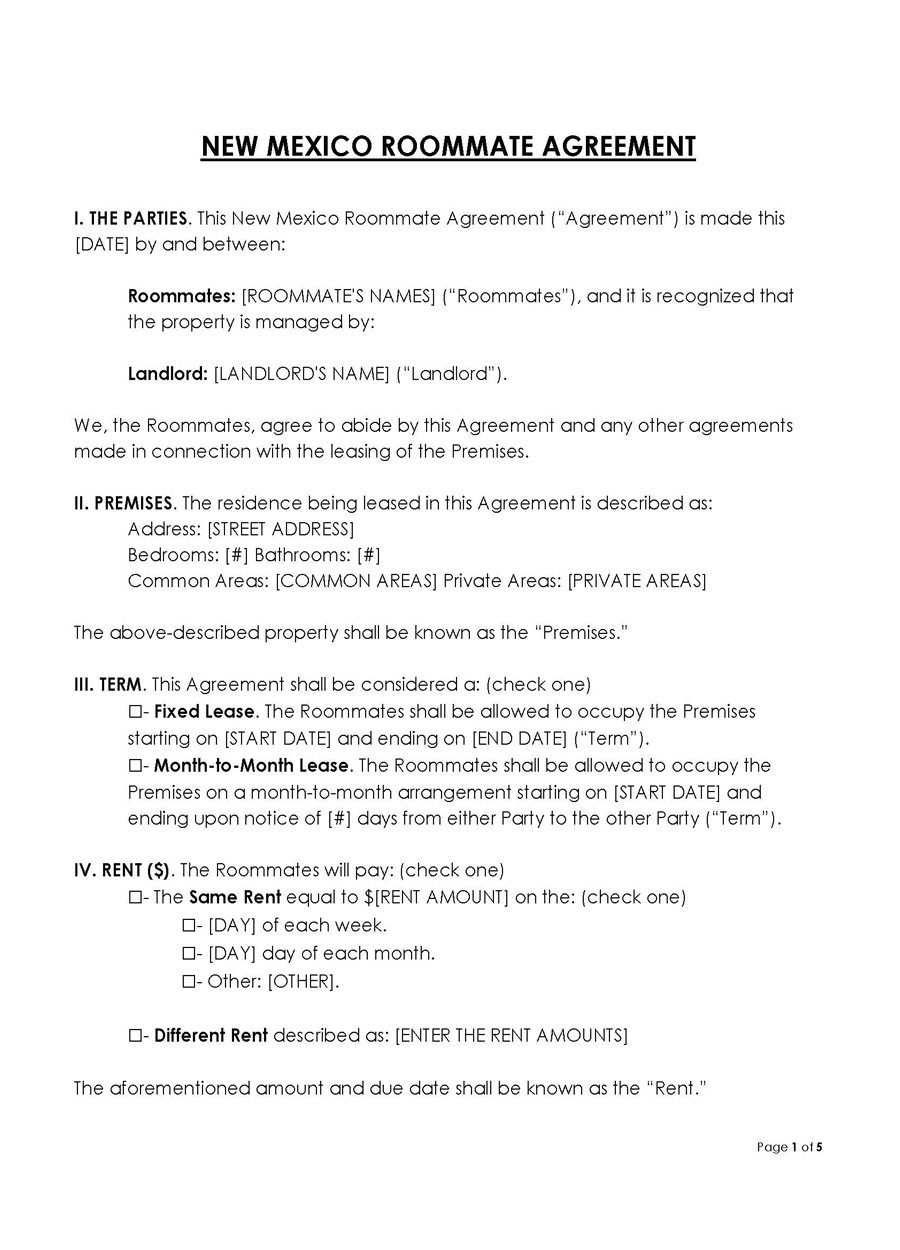
This agreement is used when two tenants agree to cohabit in a single property. In this type of agreement, the rules guiding both roommates are stated, so each person understands their rental obligations. And when one person decides to leave the shared apartment, they are responsible for finding someone else to replace them. However, if the existing roommate doesn’t accept the newly introduced one, the tenant moving out will forfeit their deposit.
Standard lease agreement
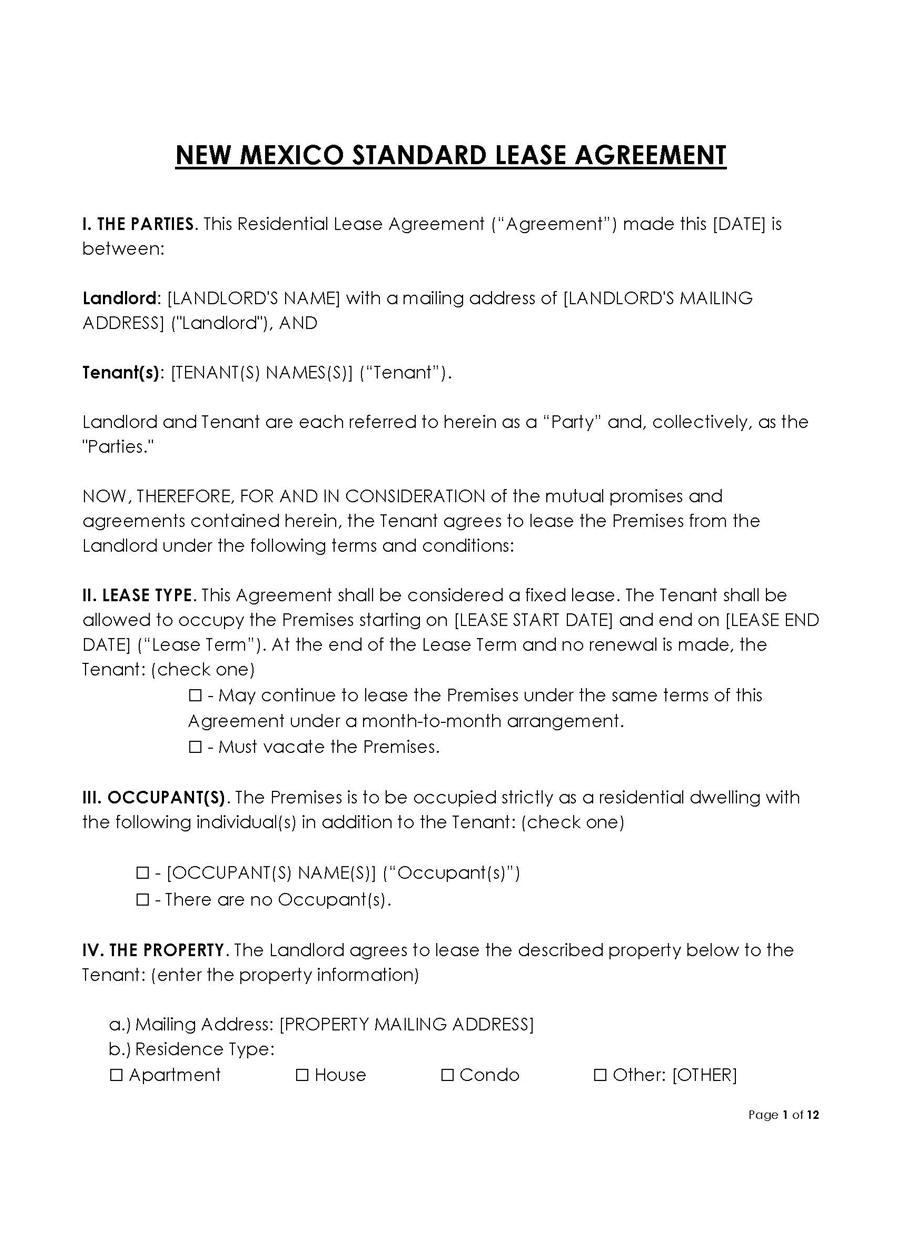
The standard lease agreement is a fixed-term legal residential contract between a landlord and tenant. In the agreement, the landlord allows the tenant to own the leased property and pay a monthly rent, usually due on the first day of every month.
Sublease agreement
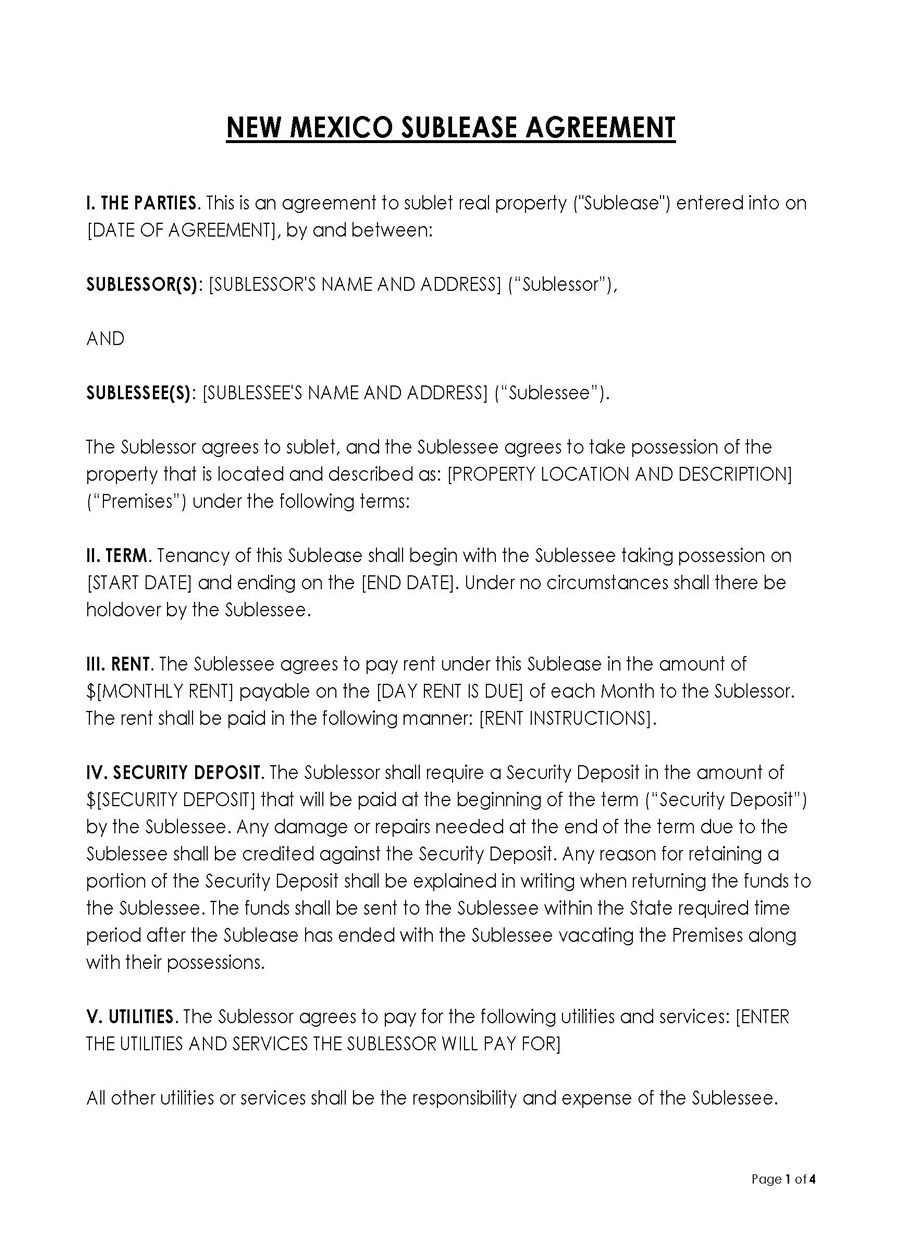
Before a tenant re-rents a leased apartment to someone else, they must get their landlord’s consent and enter a New Mexico sublease agreement to legalize the process. This agreement is binding between the master tenant, the new tenant (the sub-lessee), and the landlord. However, communications are strictly between the master tenant and landlord. In other words, the landlord can hold the master tenant responsible if the sub-lessee defaults on rent payments or breaches the contract.
Disclosures
As a landlord, you must disclose some information about your property to prospective tenants:
Landlord’s name and address
According to New Mexico’s Uniform Owner-Resident Relations Act, all the owners of the state’s rental units are obligated to disclose their names and addresses for future legal notices and demands from their tenants to be quickly sent to them. In addition, the property owner must provide the same information in writing before a lease agreement is signed.
Late fee disclosure
For housing units that charge late fees, the law expects landlords to include the fee amount and when it’s to be paid.
EXAMPLE
In New Mexico, the late payment fee is a maximum of 10% of the delayed rent amount.
Lead-based paint
By federal laws, the owner of a rental property built in New Mexico before 1978 must disclose that the building is painted with lead-based paint and attach a lead-based paint disclosure form to the lease agreement. Landlords must also provide tenants with an EPA-approved pamphlet to help them understand the risks associated with living in lead-based painted houses.
Medical marijuana use
New Mexico landlords are expected to disclose information about marijuana use in their agreements. Since the state laws allow landlords to limit marijuana usage to only non-smoking methods, they should include information like where marijuana can be smoked on the property if allowed to protect other inhabitants.
Move-in checklist
Another disclosure a landlord must include in a lease agreement is a list of the possible damages a tenant can make to the property. This will help tenants understand that they are responsible for any damages during their lease period. This document can be attached to the agreement or signed separately.
Shared utility arrangements
For shared apartments, landlords should inform all the tenants about which utilities they can share, how they are shared, and their associated bills will be paid. By doing so, each tenant will be able to calculate their additional bills based on the utilities they decide to use.
Bed bug disclosure
As a landlord, if bed bugs have ever infested your property, you must disclose this in your lease agreement and provide your potential tenant with the necessary information they need to have about managing the situation. With this knowledge, the tenant will be prepared for what is to come and cooperate with you to control the situation if it happens during their lease term.
Asbestos disclosure
For properties built before 1981, asbestos was a common building material. If a rental unit falls in this category, it’s expected that the landlord informs their prospective tenant and includes the information in the lease of agreement. This will help prevent the tenant from doing things that can damage the asbestos when fixing things in the house.
Mold disclosure
When leasing a property, a property owner must inform a potential tenant of their apartment’s mold status before signing a lease agreement, especially if the house has a similar history. This will make the tenant liable for mold damages due to their negligence while living on the property.
How to Write a New Mexico Lease Agreement
Before writing this agreement, there is certain information you should be aware of. In addition, lease agreements are legal documents, so if you have any challenges or uncertainties about the terms used, you should speak with an attorney before signing them.
Names of landlord and tenant
The landlord’s name or the property management company in charge of the building and the tenant’s (s)’ legal name(s) must be written on document.
Property location
This is the full address of the property’s location. In addition, information like the zip code and property number should also be included.
Lease term details
This is the information about the type of lease agreement the landlord and tenant are entering. Also, the kind of agreement and the lease length should be clearly stated in the agreement.
Rent payment details
This section should include the lease’s start date, monthly rent amount, the specific day the rent is due, and where the rent should be paid.
Late payment fee/penalty
This is the amount the tenant must pay after defaulting to pay their rent on the set time.
Security deposit
This is the deposit a tenant must pay before moving into the property. It is usually kept by the landlord to fix damages caused by the tenant. You, as a landlord, should clearly state the amount and the conditions for a refund if there are no extreme damages by the tenant.
Initial payment
This covers the total amount a tenant must pay before moving into a property. Usually, it is the addition of the first month’s rent and the security deposit.
Occupants’ information
In this section, the landlord should highlight the legal names of all the tenants in their residential property. If the tenants have partners and children, the additional names should also be included.
For commercial properties, on the other hand, the names of the lessee and everyone with access to the space should be listed. And if the tenants have to pay additional costs for having more people use the property, it should be clearly stated by the landlord.
Details of utilities
The landlord should highlight the utilities/services a tenant won’t pay for in this section.
Parking details
This section provides the tenant with information regarding a parking space. It helps the tenant understand if they’ll get a parking space or not.
Property furnishing
In this section, the landlord highlights the equipment and appliances a tenant can and cannot install. And if a tenant isn’t allowed to move in with their appliances, it should be disclosed here.
Notice information
In this section, both the landlord’s and tenant’s names and mailing addresses should be documented so that a notice can be sent there from either party.
Eviction details
This section helps the tenant understand the possible grounds for eviction, especially regarding rent payments or any other contract breach.
Additional information
The landlord can add any information they consider essential to the agreement that hasn’t been mentioned in any other sections.
Signature and date
Finally, both parties sign and date the agreement to make it legally binding.
New Mexico Lease Agreement Templates
Landlord and Tenant Laws
In New Mexico, as a landlord, you’ll find additional laws that you should pay attention to in a lease agreement:
Access
Under the state’s statutes, a property owner can access their leased property for inspection or maintenance once they’ve informed the tenant 24 hours before the visit.
Security deposit
For lease periods of a year or less, the state’s law allows a landlord to charge a prospective tenant a security deposit of up to a month’s rent. However, if the rent is more than a year, the landlord can request any amount they deem fair. And if the deposit costs more than a month’s rent, the landlord must agree to pay interest to the tenant.
Similarly, the deposit must be returned to the tenant within 30 days of moving out of the landlord’s property.
Frequently Asked Questions
As in many other states, a New Mexico residential lease has a maximum tenure of 1 year. If both parties want a more extended leasing period, they must write the agreement.
Yes. A contract to lease is legally enforceable in New Mexico. Once the landlord presents the tenant with a written and signed agreement and the tenant signs, the contract becomes legally binding.
You don’t need to notarize lease agreements in New Mexico as long as it meets the state’s legal requirements and is signed by both parties.
Yes. A lease can automatically renew if a tenant doesn’t initiate the lease renewal clause by giving their landlord a 30-day notice to move.
